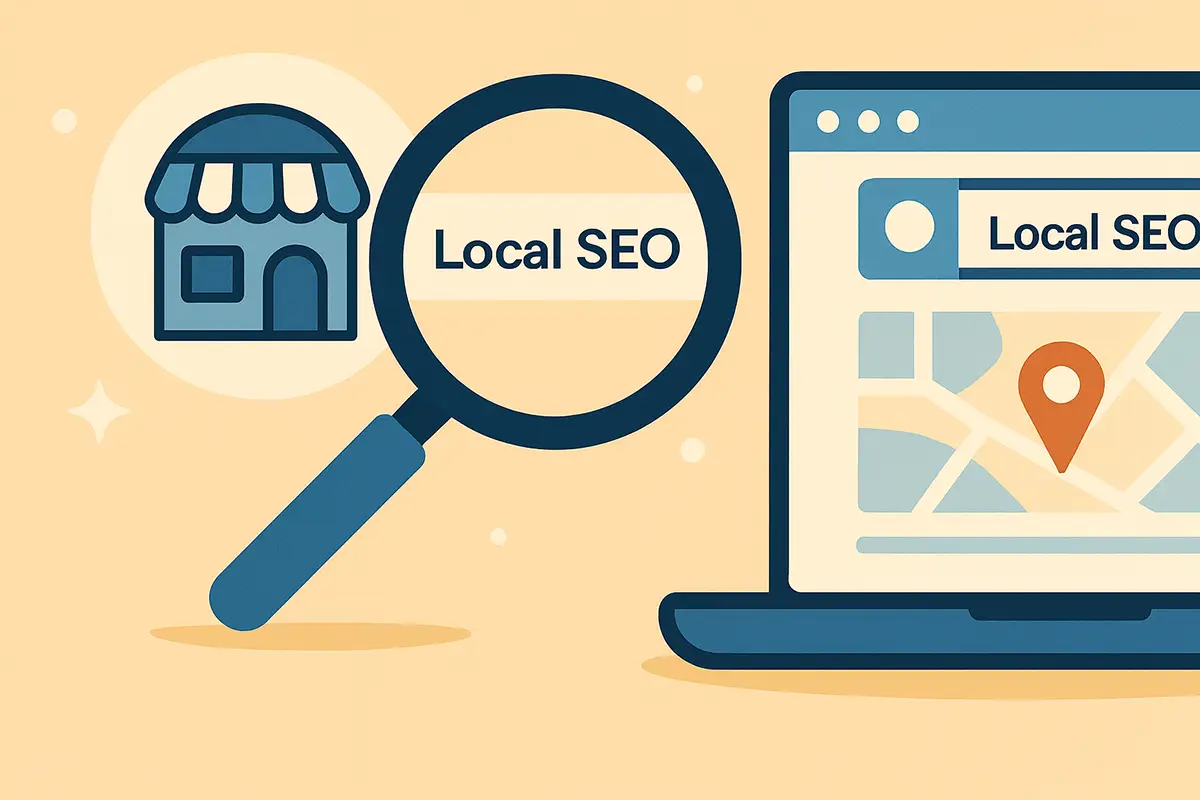In 2025, when most local searches happen on mobile, and competition in the Google Map Pack is tougher than ever, one question still pops up constantly:
“Do I need a website for local SEO?”
Short answer? Yes. But not just any website—a strategic, optimized one.
If you’re a service-area business, a brick-and-mortar shop, or a solo contractor wondering if it’s worth the investment, this guide breaks it down with real talk, no fluff, and the results-driven strategy Redshift Local is known for. Brick and mortar businesses, in particular, have unique needs and can benefit greatly from local SEO strategies that drive foot traffic and increase visibility in location-based searches.
What Is Local SEO?
Local SEO is the practice of optimizing your business to show up in local search results (also known as local search engine optimization), especially on Google. You know those “plumber near me” or “best coffee shop in [city]” searches? That’s local SEO in action.
Local search engine optimization is a specialized form of search engine optimization (SEO), which is the broader practice of improving your business’s visibility and ranking in search engine results. Local SEO focuses specifically on connecting your business with nearby customers through local search results.
It’s built around geographic relevance, which means you’re targeting people in your city, your neighborhood, your zip code.
Key areas of local SEO include:
- Google Business Profile optimization
- NAP consistency (Name, Address, Phone) across directories
- Local keyword targeting on your site
- Customer reviews and reputation management
- On-page and off-page SEO strategies
A search engine plays a crucial role in local SEO by connecting local businesses with people searching for services or products in their area.
But where does a website come in? Let’s unpack that.
Can You Do Local SEO Without a Website?
Technically, yes. You can:
- Set up a Google Business Profile (GBP), a free tool provided by Google
- Create and optimize your business listing on major platforms and local listings
- Get listed on Yelp, Bing Places, Apple Maps
- Collect reviews and add photos
- Show up in the Google Map Pack and on Google Maps
For micro-businesses or those just starting out, this is a valid starting point. Local business owners can use these strategies to serve customers in their area, but must ensure their business profiles contain accurate information and correct information to avoid issues with visibility.
But here’s the hard truth:
Without a website, you’re building your house on rented land.
Platforms like Google can change overnight. Algorithm updates, suspensions, or competitors with better-optimized listings can wipe you off the map—literally.
Plus, without a website:
- You won’t rank in organic local results
- You lose out on long-tail keyword traffic
- You miss conversion opportunities (contact forms, lead magnets, etc.)
- You miss out on relevant searches and online searches that could bring in more customers
It’s also important to keep your business listing up to date with accurate and correct information to serve customers effectively.
Why a Website Is Critical for Long-Term Local SEO Success
Let’s break this down by what a website actually gives you in a local SEO strategy:
A well-organized website structure is essential for local SEO, as it helps both users and search engines easily navigate your site and find relevant information.
3.2 Your Website as a Local SEO Foundation
Your website acts as the foundation for your local SEO efforts. Optimizing your website helps search engines understand your services and locations, which is crucial for improving your visibility in local search results. It’s important to have multiple pages, each targeting a specific service or location, to avoid keyword cannibalization and maximize your reach. You should create landing pages for each location or service you offer, ensuring they are optimized with localized keywords and relevant information. Including engaging content on these pages can boost user interaction and improve your search rankings by making your site more attractive and informative to visitors.
3.3 Enhancing User Experience and Conversion
A well-designed website not only attracts visitors but also converts them into customers. Using visual content such as high-quality images and videos can enhance your website’s appeal and increase your conversion rate. This makes your site more engaging and helps you stand out from competitors.
Ownership & Control
Your GBP belongs to Google. Your website? That’s your digital real estate. You control what it says, how it ranks, and how it converts.
Keyword & Content Optimization
You can’t rank for “emergency roof repair in Milwaukee” with just a GBP. But with location-specific service pages, FAQs, and blog posts, your site becomes a traffic magnet.
Conversion-Ready Experience
A website lets you:
- Capture leads with forms
- Show testimonials and case studies
- Add trust badges, videos, certifications
- Build credibility fast
Backlink Building
Other websites want to link to content—not a GBP listing. A well-built website gives you SEO juice through backlinks, guest posts, and local partnerships.
Real Example: Tony the Roofer
Tony ran a roofing company in upstate New York. He relied solely on word-of-mouth and his GBP. He showed up in the map pack… sometimes. But his phone barely rang.
Once he launched a basic 3-page website—optimized for “roof repair Albany NY” and “emergency leak repair”—his traffic tripled. The new website improved Tony’s website’s seo, making it easier for customers to find him online. Reviews linked to his website. By actively collecting customer feedback and encouraging customers to leave reviews, Tony enhanced his local SEO and built a stronger reputation. Blog posts ranked. And he closed 37% more calls.

How Your Website Supports the Local SEO Ecosystem
Think of your website as the hub—every other local signal connects back to it.
- Embed your Google Map directly and use schema markup to help Google’s algorithms better understand your business location and offerings
- Ensure NAP consistency across all listings
- Complete the verification process for your business profiles to establish trust and improve visibility
- Build internal links between blog content and service pages
- Integrate your website with your social presence to strengthen local SEO signals across multiple platforms
- Pull in reviews to boost trust signals
Plus: your social media, email campaigns, and ads all convert better when they lead to a strong, fast-loading, optimized website.
Community Involvement: Building Local Connections Online and Offline
Community involvement isn’t just good PR—it’s a powerhouse move for local SEO. When local businesses actively participate in their community, both online and offline, they build trust, boost brand awareness, and climb higher in local search results.
Offline, it starts with showing up. Sponsor a local event, set up a booth at a neighborhood festival, or support a charity drive. These activities put your business in front of potential customers and show you’re invested in the local area. Every handshake, conversation, and branded banner helps build relationships that can turn into loyal customers and positive word-of-mouth.
Online, your presence matters just as much. Start by optimizing your Google Business Profile with high quality images, accurate business information, and up-to-date operating hours. Engage with local customers on social media—share photos from local events, respond to reviews, and highlight your involvement in community activities. This not only increases your visibility in local searches but also signals to search engines that you’re an active, relevant part of the local market.
Take your local SEO strategy further by creating local landing pages for each neighborhood or city you serve. Use relevant keywords like “best [service] in [city]” to target local searchers and help search engines understand exactly where you operate. These landing pages can showcase your services, highlight community involvement, and make it easy for local customers to find and contact you.
Don’t forget about local directories and citations. Listing your business in reputable local directories ensures your business name, address, and contact number are consistent everywhere online. This consistency helps search engines verify your physical location and business details, which can significantly boost your local search rankings.
With more local searches happening on mobile devices, mobile optimization is essential. Make sure your website loads quickly, looks great on any screen, and makes it easy for customers to find essential information like business hours, services, and contact details.
In short, community involvement—both online and offline—can transform your local SEO efforts. By connecting with your local area, keeping your business information up to date, and optimizing your online presence, you’ll attract more local customers, improve your local search rankings, and build a reputation as a trusted local business. That’s how you turn community connections into real business growth.
What Happens If You Skip the Website?
Here’s what you’re risking:
- Total dependence on Google’s algorithm
- No real estate for keyword content
- No lead capture strategy
- No way to track or retarget visitors
- Losing credibility to competitors who do have a clean, fast site
- Missing out on attracting more customers who are searching with local intent, as your business won’t appear in local search results or the Map Pack
If you’re growth-focused, skipping a site isn’t just short-term thinking—it’s revenue left on the table.
Redshift Local’s Take: The Minimum Viable Website (MVW)
Forget “fancy” sites. You need a Minimum Viable Website built for:
- Visibility (local keywords)
- Traffic (organic + referral)
- Conversions (calls, forms, bookings)
We build strategic MVWs using our VTC Framework™ that includes just 3 core pages:
- Homepage – Clear services, city targeting, trust signals
- Services Page – Keyword-rich, locally optimized
- Contact Page – Click-to-call, map embed, simple form
That’s it. No fluff. Just results.
FAQs: Local SEO With and Without a Website
You can, but it won’t rank in Google search the way a site will. Plus, no control over layout, speed, or tracking.
Massively. It’s the foundation for 80% of on-page and content-related local SEO signals.
A blog helps you target more keywords and build topical authority. Not essential at first, but powerful long-term.
Start lean. Even a one-page site with optimized content is better than none. Redshift Local helps businesses launch fast without bloated builds.
Final Verdict for Local Business Owners: Do You *Really* Need a Website for Local SEO?
If you’re serious about growing your business, yes—you absolutely need a website.
Your Google Business Profile gets you in the door. But your website? That’s what closes the deal, builds trust, and keeps you ranking.
Redshift Local builds fast, optimized, ROI-focused websites for small businesses who want to own their digital presence and turn clicks into clients—in under 90 days.
Ready to Get More Leads from Local Search?
Let us show you what your current setup is missing—and how a Minimum Viable Website can 3x your calls in 90 days.

